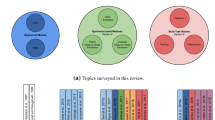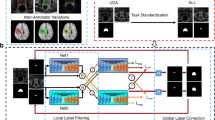Abstract
Malignant tumors that contain a high proportion of regions deprived of adequate oxygen supply (hypoxia) in areas supplied by a microvessel (i.e., a microcirculatory supply unit - MCSU) have been shown to present resistance to common cancer treatments. Given the importance of the estimation of this proportion for improving the clinical prognosis of such treatments, a manual annotation has been proposed, which uses two image modalities of the same histological specimen and produces the number and proportion of MCSUs classified as normoxia (normal oxygenation level), chronic hypoxia (limited diffusion), and acute hypoxia (transient disruptions in perfusion), but this manual annotation requires an expertise that is generally not available in clinical settings. Therefore, in this paper, we propose a new methodology that automates this annotation. The major challenge is that the training set comprises weakly labeled samples that only contains the number of MCSU types per sample, which means that we do not have the underlying structure of MCSU locations and classifications. Hence, we formulate this problem as a latent structured output learning that minimizes a high order loss function based on the number of MCSU types, where the underlying MCSU structure is flexible in terms of number of nodes and connections. Using a database of 89 pairs of weakly annotated images (from eight tumors), we show that our methodology produces highly correlated number and proportion of MCSU types compared to the manual annotations.
Gustavo Carneiro thanks the Alexander von Humboldt Foundation (Fellowship for Experienced Researchers). This work was partially supported by the Australian Research Council Projects funding scheme (project DP140102794).
Preview
Unable to display preview. Download preview PDF.
Similar content being viewed by others
References
Bayer, C., Vaupel, P.: Acute versus chronic hypoxia in tumors. Strahlentherapie und Onkologie 188(7), 616–627 (2012)
Maftei, C.A., et al.: Changes in the fraction of total hypoxia and hypoxia subtypes in human squamous cell carcinomas upon fractionated irradiation: evaluation using pattern recognition in microcirculatory supply units. Radiotherapy and Oncology 101(1), 209–216 (2011)
Yu, C.N.J., Joachims, T.: Learning structural svms with latent variables. In: ICML, pp. 1169–1176 (2009)
Kumar, M.P.: Weakly Supervised Learning for Structured Output Prediction. PhD thesis, Ecole Normale Supérieure de Cachan (2014)
Lou, X., Hamprecht, F.: Structured learning from partial annotations (2012). arXiv preprint arXiv:1206.6421
Pletscher, P., Kohli, P.: Learning low-order models for enforcing high-order statistics. In: AISTATS, pp. 886–894 (2012)
Carneiro, G., et al.: Semantic-based indexing of fetal anatomies from 3-d ultrasound data using global/semi-local context and sequential sampling. In: CVPR (2008)
Patenaude, B., et al.: A bayesian model of shape and appearance for subcortical brain segmentation. Neuroimage 56(3), 907–922 (2011)
Tu, Z., et al.: Brain anatomical structure segmentation by hybrid discriminative/generative models. TMI 27(4), 495–508 (2008)
Barbu, A., et al.: Automatic detection and segmentation of lymph nodes from ct data. TMI 31(2), 240–250 (2012)
Pauly, O., Glocker, B., Criminisi, A., Mateus, D., Möller, A.M., Nekolla, S., Navab, N.: Fast multiple organ detection and localization in whole-body MR dixon sequences. In: Fichtinger, G., Martel, A., Peters, T. (eds.) MICCAI 2011, Part III. LNCS, vol. 6893, pp. 239–247. Springer, Heidelberg (2011)
Zhou, S.K.: Discriminative anatomy detection: Classification vs regression. Pattern Recognition Letters 43, 25–38 (2014)
Fiaschi, L., et al.: Tracking indistinguishable translucent objects over time using weakly supervised structured learning. In: CVPR (2014)
Mahapatra, D., et al.: Weakly supervised semantic segmentation of crohn’s disease tissues from abdominal mri. In: ISBI (2013)
Quellec, G., et al.: Weakly supervised classification of medical images. In: ISBI (2012)
Yuille, A.L., Rangarajan, A.: The concave-convex procedure. Neural Computation 15(4), 915–936 (2003)
Joachims, T., et al.: Cutting-plane training of structural svms. Machine Learning 77(1), 27–59 (2009)
Boykov, Y., Veksler, O., Zabih, R.: Fast approximate energy minimization via graph cuts. TPAMI 23(11), 1222–1239 (2001)
Zhu, J., et al.: Multi-class adaboost. Statistics and Its (2009)
Tsochantaridis, I., et al.: Support vector machine learning for interdependent and structured output spaces. In: ICML (2004)
Breiman, L.: Random forests. Machine Learning 45(1), 5–32 (2001)
Krizhevsky, A., Sutskever, I., Hinton, G.E.: Imagenet classification with deep convolutional neural networks. In: NIPS (2012)
Grygorash, O., Zhou, Y., Jorgensen, Z.: Minimum spanning tree based clustering algorithms. In: ICTAI (2006)
Peng, T., Yigitsoy, M., Eslami, A., Bayer, C., Navab, N.: Deformable registration of multi-modal microscopic images using a pyramidal interactive registration-learning methodology. In: Ourselin, S., Modat, M. (eds.) WBIR 2014. LNCS, vol. 8545, pp. 144–153. Springer, Heidelberg (2014)
Altman, D.G., Bland, J.M.: Measurement in medicine: the analysis of method comparison studies. The statistician, 307–317 (1983)
Author information
Authors and Affiliations
Corresponding author
Editor information
Editors and Affiliations
Rights and permissions
Copyright information
© 2015 Springer International Publishing Switzerland
About this paper
Cite this paper
Carneiro, G., Peng, T., Bayer, C., Navab, N. (2015). Flexible and Latent Structured Output Learning. In: Zhou, L., Wang, L., Wang, Q., Shi, Y. (eds) Machine Learning in Medical Imaging. MLMI 2015. Lecture Notes in Computer Science(), vol 9352. Springer, Cham. https://doi.org/10.1007/978-3-319-24888-2_27
Download citation
DOI: https://doi.org/10.1007/978-3-319-24888-2_27
Published:
Publisher Name: Springer, Cham
Print ISBN: 978-3-319-24887-5
Online ISBN: 978-3-319-24888-2
eBook Packages: Computer ScienceComputer Science (R0)




